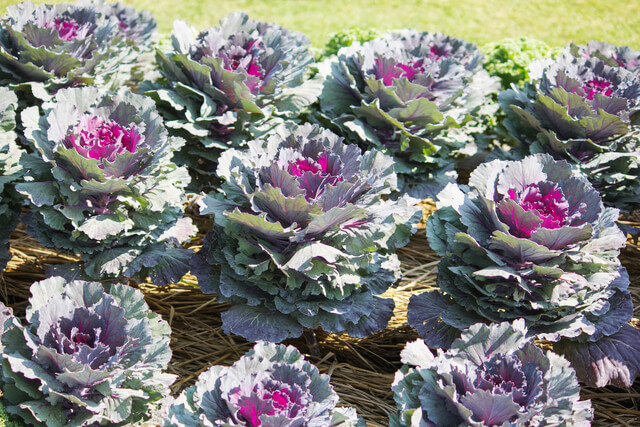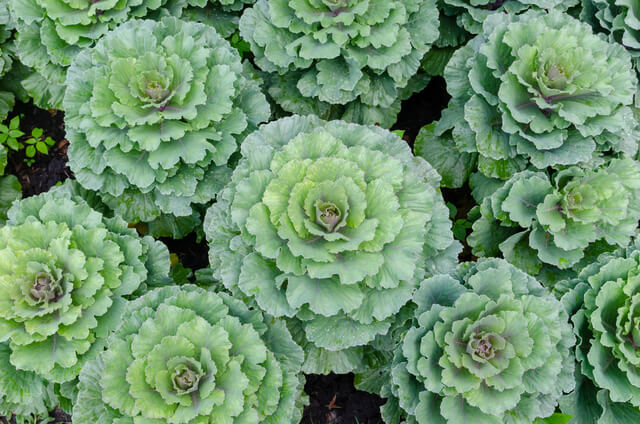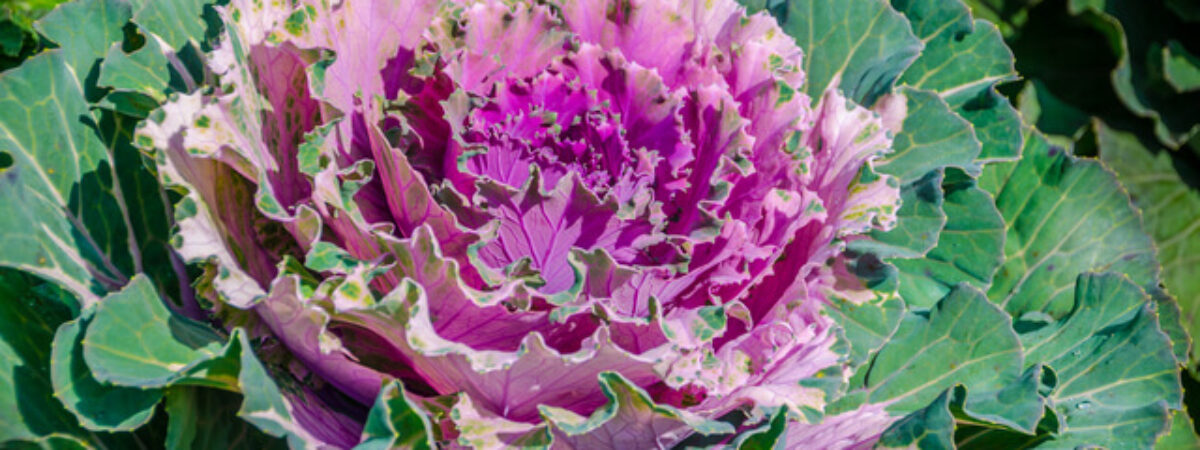Ornamental Cabbage are cool season annuals or biennials scientifically known as Brassica oleracea belongs to the Brassicaceae family. They can be grown in USDA hardiness zone 2-11.
Ornamental cabbage are quite similar to Ornamental Kale as they belong to the same family. Ornamental cabbage are native to Southern and Western Europe.
These plants are not only used for edible purposes but also they have a beautiful foliage. These plants are especially famous for their looks.
Growing ornamental cabbage is very easy right from its planting to harvesting. These are bitter in taste and hence used for garnishing in salads, pasta etc. Click To TweetGrowing ornamental cabbage is very easy right from its planting to harvesting. These are bitter in taste and hence used for garnishing in salads, pasta etc.
They will add a beautiful purple color to your food items. These plants grow in a variety of colors like pink, purple, white, dark green and even red.
They are a beautiful center point in your garden for displays especially in winters and fall season. They can be grown in containers indoors or in the ground outdoors.
Ornamental cabbage has large leaves that resemble large flowers. Its purple, rose, and creamy white leaves resemble large flowers, rather than vegetables.
It can be described as a flowering cabbage or a flowering kale depending on the type of leaf margins. According to Horticulture, flowering cabbage consists of smooth leaf margins and flat leaves
As ornamental cabbage is a biennial this means in the first year leaves grow and the flowers grow in the second year.
Types of Ornamental Cabbage
Usually Ornamental Cabbage doesn’t have a large collection of varieties to choose from as far as you are growing it for your own usage, although there are varieties for commercial purposes.
But if you want some more colors to grow then you can definitely choose from the ones that are listed below.
‘Chidori’ Ornamental kale
The leaves of this plant have extremely curly edges, and the colors are purple, creamy white, or deep magenta.
‘Color Up’ Ornamental cabbage
Plants of this genus have white, pink, or fuchsia centers and grow upright.
‘Osaka’ Ornamental cabbage
Featuring large, smooth leaves with a pink, red, or white center, this ornamental cabbage can be grown indoors or out. The foliage tends to stay compact.
‘Peacock’ Ornamental kale
The leaves are deep serrated in red, purple, or white and it looks more like its edible cousin, kale.
‘Pigeon’ series Ornamental cabbage
A flattened form with a red or white center distinguishes this variety.
Growing and Caring guide

Ornamental cabbage is best grown in the cold season i.e winters. The beautiful colors of the plants are best achieved when they get the cool temperature for their growth.
There are some basic requirements that need to be fulfilled for the Ornamental Cabbage to grow healthy.
In order to grow these plants in your backyard, you need to have some knowledge on its Soil, light, water and fertilizer requirements.
Soil
Ornamental Cabbage prefers loamy soil with high organic content. They grow best in acidic pH i.e 5.5 to 6.5. The soil should have good drainage capacity that holds moisture required by the plant.
Light
Ornamental cabbage requires sufficient light to grow. They can be grown in partial shade conditions during summers otherwise in winters full Sunlight is good for their healthy growth.
Watering
Ornamental Cabbage requires a good amount of watering. Keep the soil moist and always check the top most soil with your hands to know whether they have dried out or not.
Immediately water the plants if you notice dryness in soil. If you are growing these plants in pots/containers then they require a little bit more watering than those on ground.
So these plants require 1 inch of watering like most of the plants whether through Rain or manual watering.
Temperature and Humidity
Ornamental cabbage plants are frost-tolerant plants. In fact, they grow with full color if they get an adequate amount of cool weather.
Ornamental cabbage plants are frost tolerant plants. In fact they grow with full color if they get an adequate amount of cool weather. Click To TweetThey grow best in temperatures above 5 degree celsius and if the temperature falls below this then the plants might die.
Medium humidity is required by these plants with good air circulation. The plants will develop fungal diseases if they are exposed to too much humidity.
Fertilization
During the planting of Ornamental cabbage, fertilizer should be applied. After that they dont require fertilization.
Do not apply any fertilizer while they are growing as that will affect their growth as well as color.
Growing Ornamental Cabbage from Seed
If you want to plant your Ornamental Cabbage during fall season, then you should start planting the seeds during July first week in a pot. Then plant the seedling during mid August in your garden.
Whereas if you want to display the Ornamental Cabbage during Spring, then you should plant the seeds in a pot/container at least six to eight weeks before the last frost expected.
Then plant the seedlings in your garden during early spring. In order to grow the seedlings from seeds indoors, you need to follow some basic steps.
At first you need to fill your pot with a seed starter, mix soil and then sow the seeds in them. Sow the seeds at a depth of ¼ inch and keep the pot at 70 degree fahrenheit in a brighter area.
Regular watering is required for the seedlings to grow healthy.
You will notice that the seedlings are riding out of the pots, usually it takes 10 to 21 days for the seedlings to come. At this time you can transfer the seedlings to your garden .
If you are growing the plants as biennials then you can keep the seeds and store it in a freezer and use them for next planting.

Common problems in Ornamental Cabbage
As Ornamental Cabbage is an edible vegetable that belongs to Brassica genus i.e Cabbage family. These too are attacked by the pests of cabbage such as cabbage worms, cabbage loopers, flea beetles, caterpillars, thrips, slugs, and aphids.
These pest attacks can be cured using hard water sprays but only if the infection has just started i.e initial stage.
In case of heavy infestation, you can always use a vegetable pesticide to control the pest attack. If these plants are grown in pots/containers then the pest attack is less likely to occur.
Similarly in damp soil and weather conditions, these plants develop fungal diseases such as leaf spots, blackleg and black rot.
These plants are not only used as ornamental plants but also as vegetables too. So it becomes obvious that they are susceptible to some common diseases that usually occur in vegetables.
Conclusion
As cruciferous vegetables, Ornamental cabbages are an excellent choice for a vegetable garden laden with green vegetables.
Although they grow rapidly, these plants are usually grown as annuals for their beautiful foliage. They are planted from nursery in fall or early spring, and are then removed once they are done blooming.
Hope you have like this guide on how to grow Ornamental Cabbages and this will definitely help you to grow these plants in your own garden and enjoy its beauty as well as having it in your salads or in any of your favorite food.






